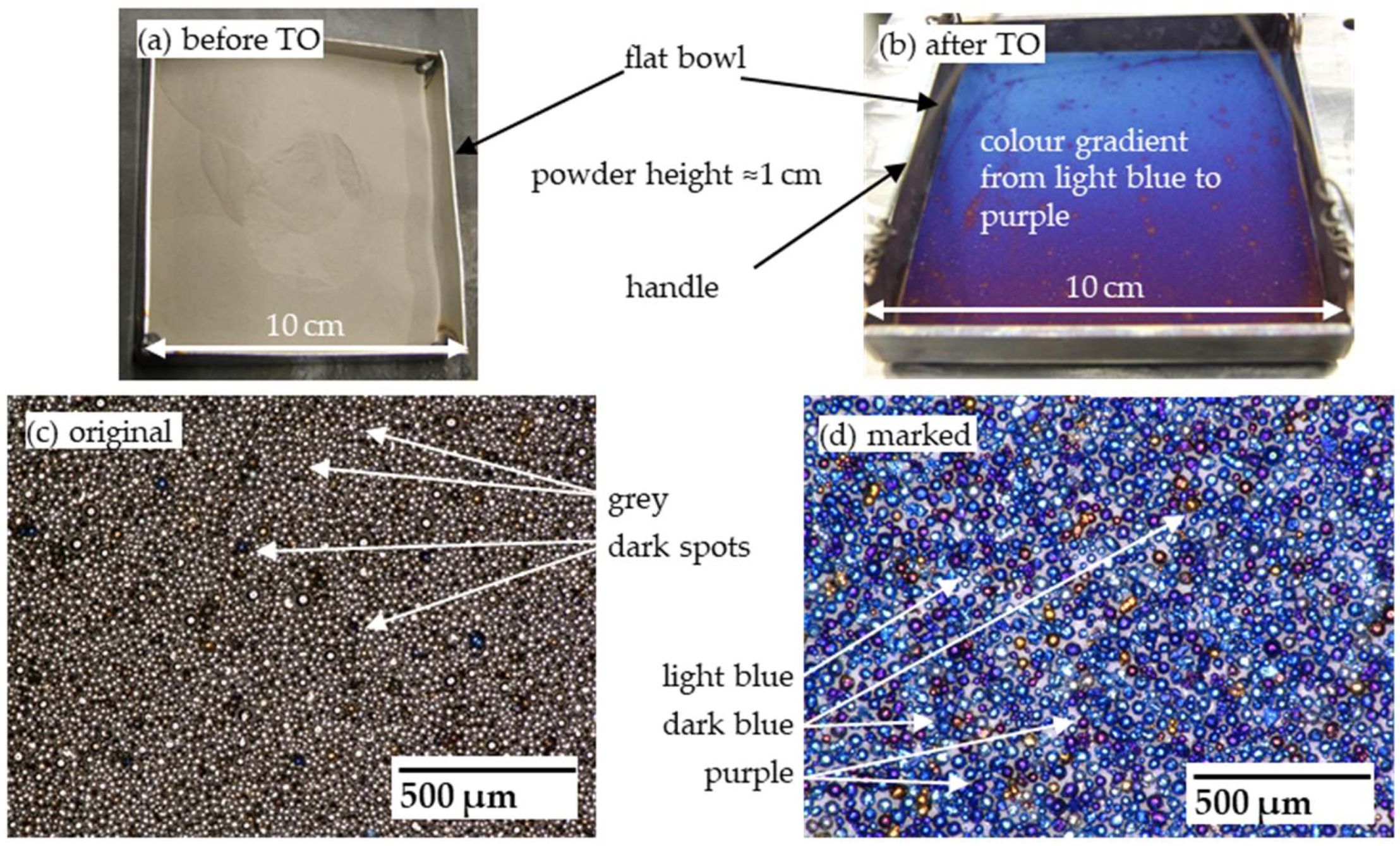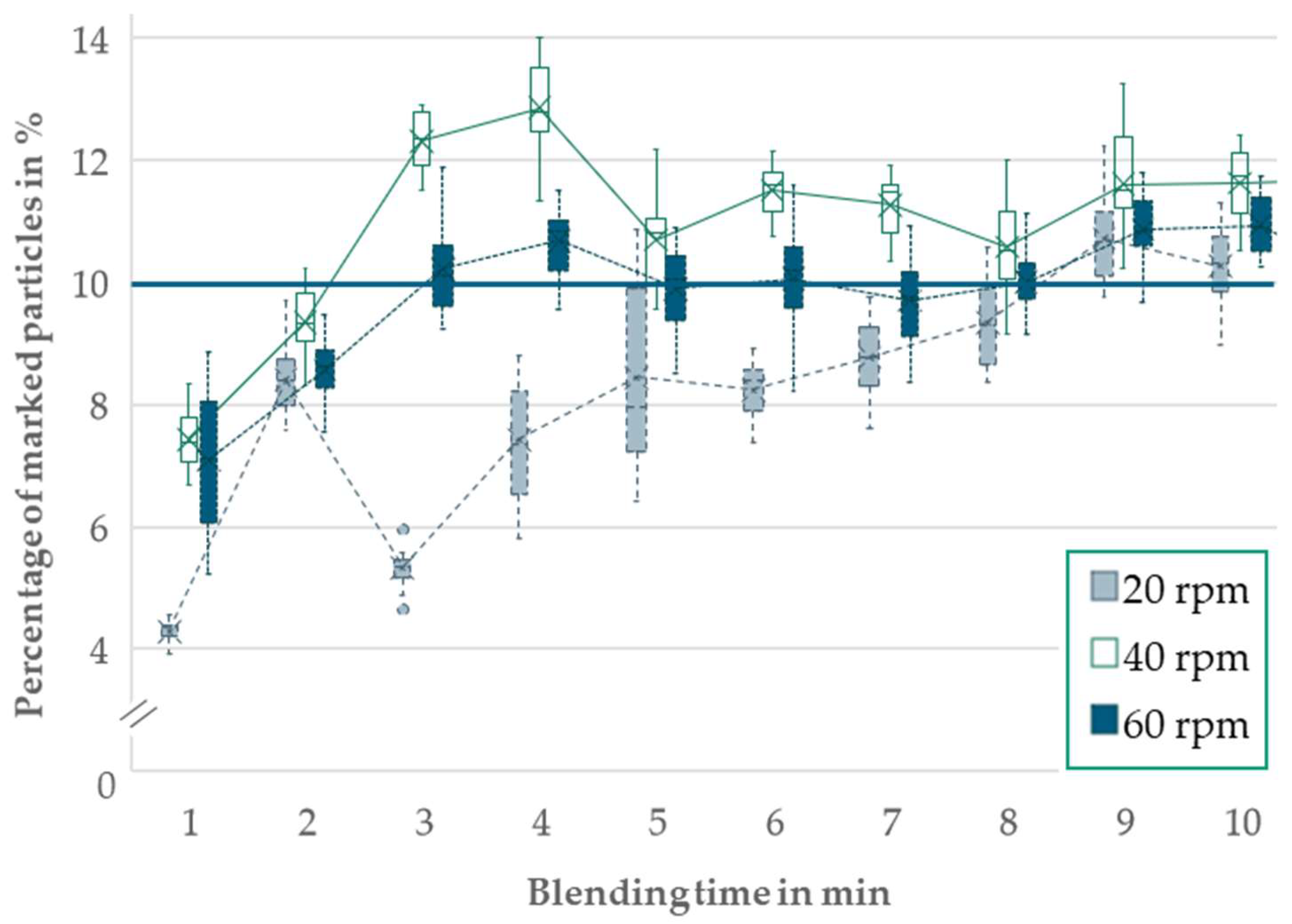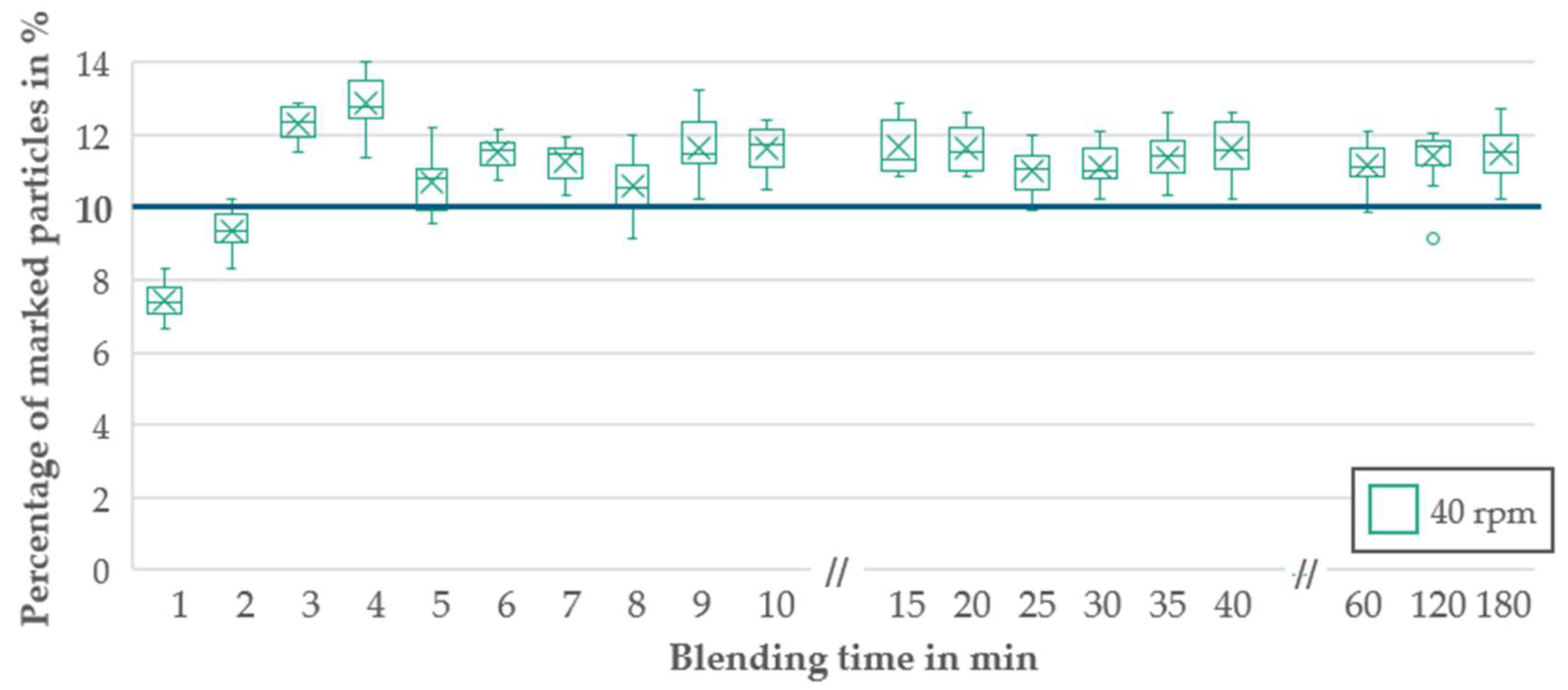Investigation of Metal Powder Blending for PBF-LB/M Using Particle Tracing with Ti-6Al-4V
Abstract
:1. Introduction
2. Materials and Methods
2.1. Blender Development
2.2. Powder Marking
2.3. Verification of Blending Grade
3. Results
3.1. Development of Powder Blender
3.1.1. Blender Type Assessment
3.1.2. Development
3.2. Verification of Blending Grade
3.2.1. Particle Marking
3.2.2. Blending Result
4. Discussion
4.1. Blender Development
4.2. Handling of Powder Blender
4.3. Safety
4.4. Methodology for Blending Grade Verification
4.5. Blending Result
5. Conclusions
- The tumbling blender emerged as the preferred option in AM applications, balancing performance, low complexity, and scalability.
- The implementation of particle tracing using thermal oxidation enabled the effective differentiation of powders for thorough blending validation for initial operation.
- The impact of the blending process with Fr < 1 was low enough not to affect the particle properties, size, or shape.
- A blend with a completely random state could be achieved in 3 min at 60 rpm and in under 10 min at 20 rpm.
- Handling procedures, particularly concerning inert gas flooding, require optimization to enhance operational efficiency and safety.
Author Contributions
Funding
Data Availability Statement
Conflicts of Interest
References
- AMPOWER. Additive Manufacturing Market Report 2024: AMPOWER Market Report; AMPOWER GmbH & Co. KG: Hamburg, Germany, 2024. [Google Scholar]
- Ludwig, I.; Kluge, M.; Jutkuhn, D.; Grube, M.; Imgrund, P.; Emmelmann, C. Investigations of air atomized and coarser gas-atomized AlSi12 powders to evaluate cost reduction potentials for additive manufacturing processes. In Proceedings of the 2021 European Powder Metallurgy Congress and Exhibition, Online, 18–22 October 2021. [Google Scholar]
- VDI 3405 Part 2.7; Additive Manufacturing Processes—Powder Bed Fusion of Metals Using a Laser Beam (PBF-LB/M):—Periphery and Workflow. VDI—The Association of German Engineers: Düsseldorf, Germany, 2023.
- Daumann, B.; Nirschl, H. Bestimmung des Mischgüteverlaufes mit Hilfe der Bildauswertung beim diskontinuierlichen Feststoffmischen. Fraunhofer IRB Verlag. In Proceedings of the 4th Symposium Produktgestaltung in der Partikeltechnologie, Pfinztal, Germany, 12–13 June 2008. [Google Scholar]
- Kraume, M. Mischen und Rühren. In Transportvorgänge in der Verfahrenstechnik: Grundlagen und apparative Umsetzungen; Springer: Berlin/Heidelberg, Germany, 2020; pp. 733–798. [Google Scholar] [CrossRef]
- Paul, E.L.; Atiemo-Obeng, V.A.; Kresta, S.M. Handbook of Industrial Mixing: Science and Practice; Wiley-Interscience: Hoboken, NJ, USA, 2004. [Google Scholar]
- Weinekötter, R.; Gericke, H. Mischen von Feststoffen: Prinzipien, Verfahren, Mischer; Springer: Berlin/Heidelberg, Germany, 1995. [Google Scholar]
- Schubert, H. Handbuch der mechanischen Verfahrenstechnik: Partikeleigenschaften, Mikroprozesse, Makroprozesse, Schüttgut; Wiley-VCH: Weinheim, Germany, 2002. [Google Scholar]
- Schulze, D. Pulver und Schüttgüter; Springer: Berlin/Heidelberg, Germany, 2014. [Google Scholar]
- Thamae, M.; Maringa, M.; Preez, W.B.D. Parameters Affecting the Mixing of Powders and the Results of Mixing SiC and Ti6Al4V (ELI) Powders. In Proceedings of the 22nd Annual International RAPDASA Conference, Pretoria, South Africa, 30 October–2 November 2023. [Google Scholar]
- Young, Z.; Qu, M.; Coday, M.M.; Guo, Q.; Hojjatzadeh, S.M.H.; Escano, L.I.; Fezzaa, K.; Chen, L. Effects of Particle Size Distribution with Efficient Packing on Powder Flowability and Selective Laser Melting Process. Materials 2022, 15, 705. [Google Scholar] [CrossRef]
- Cordova, L.; Campos, M.; Tinga, T. Revealing the Effects of Powder Reuse for Selective Laser Melting by Powder Characterization. JOM 2019, 71, 1062–1072. [Google Scholar] [CrossRef]
- Tang, H.P.; Qian, M.; Liu, N.; Zhang, X.Z.; Yang, G.Y.; Wang, J. Effect of Powder Reuse Times on Additive Manufacturing of Ti-6Al-4V by Selective Electron Beam Melting. JOM 2015, 67, 555–563. [Google Scholar] [CrossRef]
- Quintana, O.A.; Alvarez, J.; Mcmillan, R.; Tong, W.; Tomonto, C. Effects of Reusing Ti-6Al-4V Powder in a Selective Laser Melting Additive System Operated in an Industrial Setting. JOM 2018, 70, 1863–1869. [Google Scholar] [CrossRef]
- Warner, J.H.; Ringer, S.P.; Proust, G. Strategies for metallic powder reuse in powder bed fusion: A review. J. Manuf. Process. 2024, 110, 263–290. [Google Scholar] [CrossRef]
- Raza, A.; Fiegl, T.; Hanif, I.; MarkstrÖm, A.; Franke, M.; Körner, C.; Hryha, E. Degradation of AlSi10Mg powder during laser based powder bed fusion processing. Mater. Des. 2021, 198, 109358. [Google Scholar] [CrossRef]
- Soltani-Tehrani, A.; Isaac, J.P.; Tippur, H.V.; Silva, D.F.; Shao, S.; Shamsaei, N. Ti-6Al-4V powder reuse in laser powder bed fusion (L-PBF): The effect on porosity, microstructure, and mechanical behavior. Int. J. Fatigue 2023, 167, 107343. [Google Scholar] [CrossRef]
- Delacroix, T.; Lomello, F.; Schuster, F.; Maskrot, H.; Garandet, J.-P. Influence of powder recycling on 316L stainless steel feedstocks and printed parts in laser powder bed fusion. Addit. Manuf. 2022, 50, 102553. [Google Scholar] [CrossRef]
- Lutter-Günther, M.; Gebbe, C.; Kamps, T.; Seidel, C.; Reinhart, G. Powder recycling in laser beam melting: Strategies, consumption modeling and influence on resource efficiency. Prod. Eng. Res. Devel. 2018, 12, 377–389. [Google Scholar] [CrossRef]
- Kusoglu, I.M.; Gökce, B.; Barcikowski, S. Research trends in laser powder bed fusion of Al alloys within the last decade. Addit. Manuf. 2020, 36, 101489. [Google Scholar] [CrossRef]
- Kohlwes, P.; Ludwig, I.; Kouhestani-Farouji, A.; Herzog, D.; Emmelmann, C. Influence Analysis of Individual Powder Properties on L-PBF Process Capability. In Proceedings of the Fraunhofer Direct Digital Manufacturing Conference DDMC, Berlin, Germany, 15–16 March 2023; ISBN 978-3-8396-1895-0. [Google Scholar]
- Ludwig, I.; Kluge, M. Investigation of an Increased Particle Size Distribution of Ti-6Al-4V Powders Used for Laser-Based Powder Bed Fusion of Metals. Materials 2024, 17, 2942. [Google Scholar] [CrossRef] [PubMed]
- Haferkamp, L.; Liechti, S.; Spierings, A.; Wegener, K. Effect of bimodal powder blends on part density and melt pool fluctuation in laser powder bed fusion. Prog. Addit. Manuf. 2021, 6, 407–416. [Google Scholar] [CrossRef]
- Churu, V.A. Homogenisation of Ti6Al4V Powder Blends during Sintering; University of Capetown: Cape Town, South Africa, 2022. [Google Scholar]
- Huang, G.; Fan, Z.; Li, L.; Lu, Y.; Lin, J. Corrosion Resistance of Selective Laser Melted Ti6Al4V3Cu Alloy Produced Using Pre-Alloyed and Mixed Powder. Materials 2022, 15, 2487. [Google Scholar] [CrossRef] [PubMed]
- Ma, G.; Dong, S.; Song, Y.; Qiu, F.; Savvakin, D.; Ivasishin, O.; Cheng, T. Sustaining an excellent strength–ductility combination for Ti–6Al–4V alloy prepared from elemental powder blends. J. Mater. Res. Technol. 2023, 23, 4965–4975. [Google Scholar] [CrossRef]
- Ekaputra, C.N.; Weiss, D.; Mogonye, J.-E.; Dunand, D.C. Eutectic, precipitation-strengthened alloy via laser fusion of blends of Al-7Ce-10Mg (wt.%), Zr, and Sc powders. Acta Mater. 2023, 246, 118676. [Google Scholar] [CrossRef]
- Li, H.; Brodie, E.G.; Hutchinson, C. Predicting the chemical homogeneity in laser powder bed fusion (LPBF) of mixed powders after remelting. Addit. Manuf. 2023, 65, 103447. [Google Scholar] [CrossRef]
- Hantke, N.; Großwendt, F.; Strauch, A.; Fechte-Heinen, R.; Röttger, A.; Theisen, W.; Weber, S.; Sehrt, J.T. Processability of a Hot Work Tool Steel Powder Mixture in Laser-Based Powder Bed Fusion. Materials 2022, 15, 2658. [Google Scholar] [CrossRef]
- Parker, B.S. Blending of Powders for In-Situ Alloying of Ti6Al4V Laser Powder Bed Fusion; Faculty of Engineering, Stellenbosch University: Stellenbosch, South Africa, 2021. [Google Scholar]
- Priyadarshi, A.; Shahrani, S.B.; Choma, T.; Zrodowski, L.; Qin, L.; Leung, C.L.A.; Clark, S.J.; Fezzaa, K.; Mi, J.; Lee, P.D.; et al. New insights into the mechanism of ultrasonic atomization for the production of metal powders in additive manufacturing. Addit. Manuf. 2024, 83, 104033. [Google Scholar] [CrossRef]
- Daumann, B. Untersuchungen zum Dispersions- und Transportverhalten von Feststoffmischungen Unterschiedlicher Partikelgrößen in Diskontinuierlichen Feststoffmischern, 1. Aufl.; Cuvillier Verlag: Göttingen, Germany, 2010; ISBN-13 9783736935006. [Google Scholar]
- Müller, W. Methoden und derzeitiger Kenntnisstand für Auslegungen beim Mischen von Feststoffen. Chem. Ing. Tech. 1981, 53, 831–844. [Google Scholar] [CrossRef]
- Langhorn, K. Selecting Appropriate Powder Blender. Available online: https://www.powderbulksolids.com/mixers-blenders/selecting-appropriate-powder-blender (accessed on 19 May 2023).
- VDI 2225 Part 3; Design Engineering Methodics—Engineering Design at Optimum Cost—Valuation of Costs. VDI—The Association of German Engineers: Düsseldorf, Germany, 1998.
- VDI 2221; Systematic Approach to the Development and Design of Technical Systems and Products. VDI—The Association of German Engineers: Düsseldorf, Germany,, 1993.
- VDI 3405 Part 6.1; Additive Manufacturing Processes—User Safety on Operating the Manufacturing Facilities—Laser Beam Melting of Metallic Parts. VDI—The Association of German Engineers: Düsseldorf, Germany, 2018.
- Patel, S.B.; Hamlekhan, A.; Royhman, D.; Butt, A.; Yuan, J.; Shokuhfar, T.; Sukotjo, C.; Mathew, M.T.; Jursich, G.; Takoudis, C.G. Enhancing surface characteristics of Ti–6Al–4V for bio-implants using integrated anodization and thermal oxidation. J. Mater. Chem. B 2014, 2, 3597. [Google Scholar] [CrossRef]
- Karambakhsh, A.; Afshar, A.; Ghahramani, S.; Malekinejad, P. Pure Commercial Titanium Color Anodizing and Corrosion Resistance. J. Mater. Eng. Perform. 2011, 20, 1690–1696. [Google Scholar] [CrossRef]
- Gaul, E. Coloring titanium and related metals by electrochemical oxidation. J. Chem. Educ. 1993, 70, 176. [Google Scholar] [CrossRef]
- Diamanti, M.V.; Del Curto, B.; Pedeferri, M. Interference colors of thin oxide layers on titanium. Color. Res. Appl. 2008, 33, 221–228. [Google Scholar] [CrossRef]
- ISO 13322-2; Particle Size Analysis—Image Analysis Methods: Part 2: Dynamic Image Analysis Methods. ISO: Geneva, Switzerland, 2006.
- Driewer, A. Manual Particle Size Analyser Camsizer X2; Microtrac Retsch GmbH: Haan, Germany, 2020. [Google Scholar]
- DIN EN ISO 3923-1; Metallic Powders—Determination of Apparent Density: Part 1: Funnel Method. ISO: Geneva, Switzerland, 2018.
- DIN EN ISO 3953; Metallic Powders—Determination of Tap Density. ISO: Geneva, Switzerland, 2011.
- Hausner, H.H. Powder Characteristics and their Effect on Powder Processing. Powder Technol. 1981, 30, 3–8. [Google Scholar] [CrossRef]
- DIN EN ISO 4490; Metallic Powders—Determination of Flow Rate by Means of a Calibrated Funnel. DIN-Normenausschuss Werkstofftechnologie (NWT): Berlin, Germany, 2009.
- Bhattacharya, A. Difference between a Double Cone Blender and A V Blender. Available online: https://www.abilityfab.com/difference-between-double-cone-blender-and-v-blender/#:~:text=A%20double%20cone%20blender%20is,of%201%20to%202%20percent (accessed on 19 May 2023).
- Song, T.; Chen, Z.; Cui, X.; Lu, S.; Chen, H.; Wang, H.; Dong, T.; Qin, B.; Chan, K.C.; Brandt, M.; et al. Strong and ductile titanium-oxygen-iron alloys by additive manufacturing. Nature 2023, 618, 63–68. [Google Scholar] [CrossRef]
- Dietrich, K.; Diller, J.; Goff, S.D.-L.; Bauer, D.; Witt, P.F.U.G. The influence of oxygen on the chemical composition and mechanical properties of Ti-6Al-4V during laser powder bed fusion (L-PBF). Addit. Manuf. 2020, 32, 100980. [Google Scholar] [CrossRef]
- ASTM E2371-21a; Standard Test Method for Analysis of Titanium and Titanium Alloys by Direct Current Plasma and Inductively Coupled Plasma Atomic Emission Spectrometry (Performance-Based Test Methodology). ASTM: West Conshohocken, PN, USA, 2022.
- Muthuswamy, P. Influence of powder characteristics on properties of parts manufactured by metal additive manufacturing. Lasers Manuf. Mater. Process. 2022, 9, 312–337. [Google Scholar] [CrossRef]
- Wallner, S. Powder Production Technologies. Berg. Huettenmaenn Monatsh 2019, 164, 108–111. [Google Scholar] [CrossRef]
- Meier, B.; Warchomicka, F.; Petrusa, J.; Angerer, P.; Wosik, J.; Kaindl, R.; Petrovic, V.; Waldhauser, W. Influence of Powder Production Process and Properties on Material Properties of Ti 6Al 4V Manufactured by L-PBF. Int. J. Adv. Manuf. Technol. 2022, 123, 1577–1588. [Google Scholar] [CrossRef]
- DIN EN ISO 3954; Pulver für die Pulvermetallurgie_Probenahme (ISO_3954:2007). Deutsche Fassung EN_ISO_3954:2007. DIN: Berlin, Germany, 2007.
- Yusuf, S.M.; Choo, E.; Gao, N. Comparison between Virgin and Recycled 316L SS and AlSi10Mg Powders Used for Laser Powder Bed Fusion Additive Manufacturing. Metals 2020, 10, 1625. [Google Scholar] [CrossRef]







| No. | Category | Requirement Description | Target |
|---|---|---|---|
| 1.1 | Container | Volume of the blend container | 3 L (up to 10 L) |
| 1.2 | Low surface roughness | <1 µm Ra | |
| 2.1 | System Architecture | Flexible suspension system for interchangeable containers | |
| 2.2 | Discontinuous blending | ||
| 3.1 | Kinematics | Electric drive with defined rotational speed | 20, 40, 60 rpm |
| 4.1 | Interfaces | ISO-Standard interfaces | KF 40 |
| 4.2 | Possibilities for sampling during the process | (>1 places) | |
| 4.3 | Adapter unit for inert gas filling from stationary pipeline | ||
| 5.1 | Monitoring | Oxygen content monitoring at filling | <500 ppm |
| 5.2 | Overpressure measurement at operation | <4 bar | |
| 6.1 | Safety | Earthing of all components and the entire system | |
| 6.2 | Tightness against solid (powder) and gas | <3 bar | |
| 6.3 | Inert gas atmosphere in the blend chamber | Ar or N | |
| 6.4 | Emergency stop switch | ||
| 6.5 | Preservation of particle characteristics (size, shape, chemistry) |
| Principle | Tumbling Blender | Convective Blender | Pneumatic Blender |
|---|---|---|---|
| Suitability |  |  |  |
| Homogenization |  |  |  |
| Lab Scale |  |  |  |
| Low-impact Blending |  |  |  |
| Complexity |  |  |  |
| Blending Time |  |  |  |
| Cleanability |  |  |  |
| Total |  |  |  |
 very good , good
very good , good  , fair
, fair  , unsatisfactory
, unsatisfactory  , fail
, fail  .
.| Powder | Ø SPHT | Ø Symm | Ø w/L | Ø D10 in [µm] | Ø D50 in [µm] | Ø D90 in [µm] |
|---|---|---|---|---|---|---|
| Original | 0.878 | 0.929 | 0.863 | 36.4 ± 0.2 | 51.7 ± 0.1 | 96.5 ± 0.0 |
| Marked | 0.884 | 0.939 | 0.880 | 34.0 ± 0.8 | 52.1 ± 0.3 | 98.6 ± 2.5 |
| Delta | +0.006 | +0.010 | +0.017 | −2.4 | +0.4 | +2.1 |
| Powder | Apparent Density in [g/cm³] | Tapped Density in [g/cm³] | Hausner Ratio | Hall Flowability in [s/50 g] |
|---|---|---|---|---|
| Original | 2.46 ± 0.01 | 2.83 ± 0.01 | 1.15 | 23.1 ± 0.08 |
| Marked | 2.45 ± 0.00 | 2.80 ± 0.01 | 1.14 | 24.3 ± 0.29 |
| Characteristic | 90:10 | 20 rpm | 40 rpm | 60 rpm | |
|---|---|---|---|---|---|
| Particle shape | Ø SPHT | 0.879 | 0.875 | 0.877 | 0.877 |
| Ø Symm | 0.930 | 0.927 | 0.931 | 0.929 | |
| Ø w/l | 0.864 | 0.859 | 0.866 | 0.863 | |
| Particle size | Ø D10 | 36.1 | 37.6 ± 0.7 | 36.4 ± 0.9 | 37.1 ± 0.8 |
| Ø D50 | 55.4 | 56.9 ± 1.1 | 54.8 ± 0.7 | 55.2 ± 1.0 | |
| Ø D90 | 110.4 | 108.4 ± 0.7 | 106.5 ± 0.6 | 106.9 ± 0.9 | |
Disclaimer/Publisher’s Note: The statements, opinions and data contained in all publications are solely those of the individual author(s) and contributor(s) and not of MDPI and/or the editor(s). MDPI and/or the editor(s) disclaim responsibility for any injury to people or property resulting from any ideas, methods, instructions or products referred to in the content. |
© 2024 by the authors. Licensee MDPI, Basel, Switzerland. This article is an open access article distributed under the terms and conditions of the Creative Commons Attribution (CC BY) license (https://creativecommons.org/licenses/by/4.0/).
Share and Cite
Ludwig, I.; Gerassimenko, A.; Imgrund, P. Investigation of Metal Powder Blending for PBF-LB/M Using Particle Tracing with Ti-6Al-4V. J. Manuf. Mater. Process. 2024, 8, 151. https://doi.org/10.3390/jmmp8040151
Ludwig I, Gerassimenko A, Imgrund P. Investigation of Metal Powder Blending for PBF-LB/M Using Particle Tracing with Ti-6Al-4V. Journal of Manufacturing and Materials Processing. 2024; 8(4):151. https://doi.org/10.3390/jmmp8040151
Chicago/Turabian StyleLudwig, Ina, Anatol Gerassimenko, and Philipp Imgrund. 2024. "Investigation of Metal Powder Blending for PBF-LB/M Using Particle Tracing with Ti-6Al-4V" Journal of Manufacturing and Materials Processing 8, no. 4: 151. https://doi.org/10.3390/jmmp8040151






